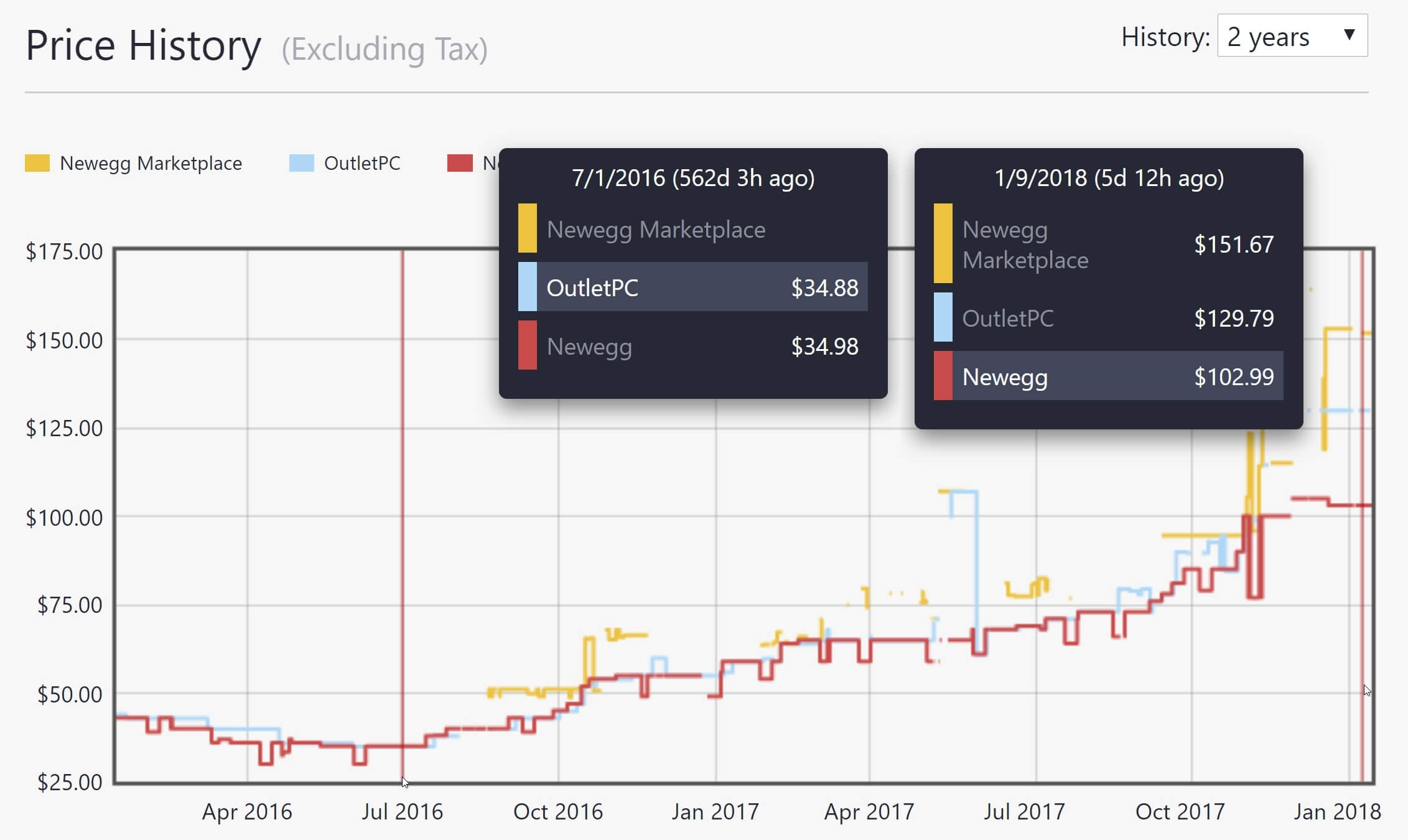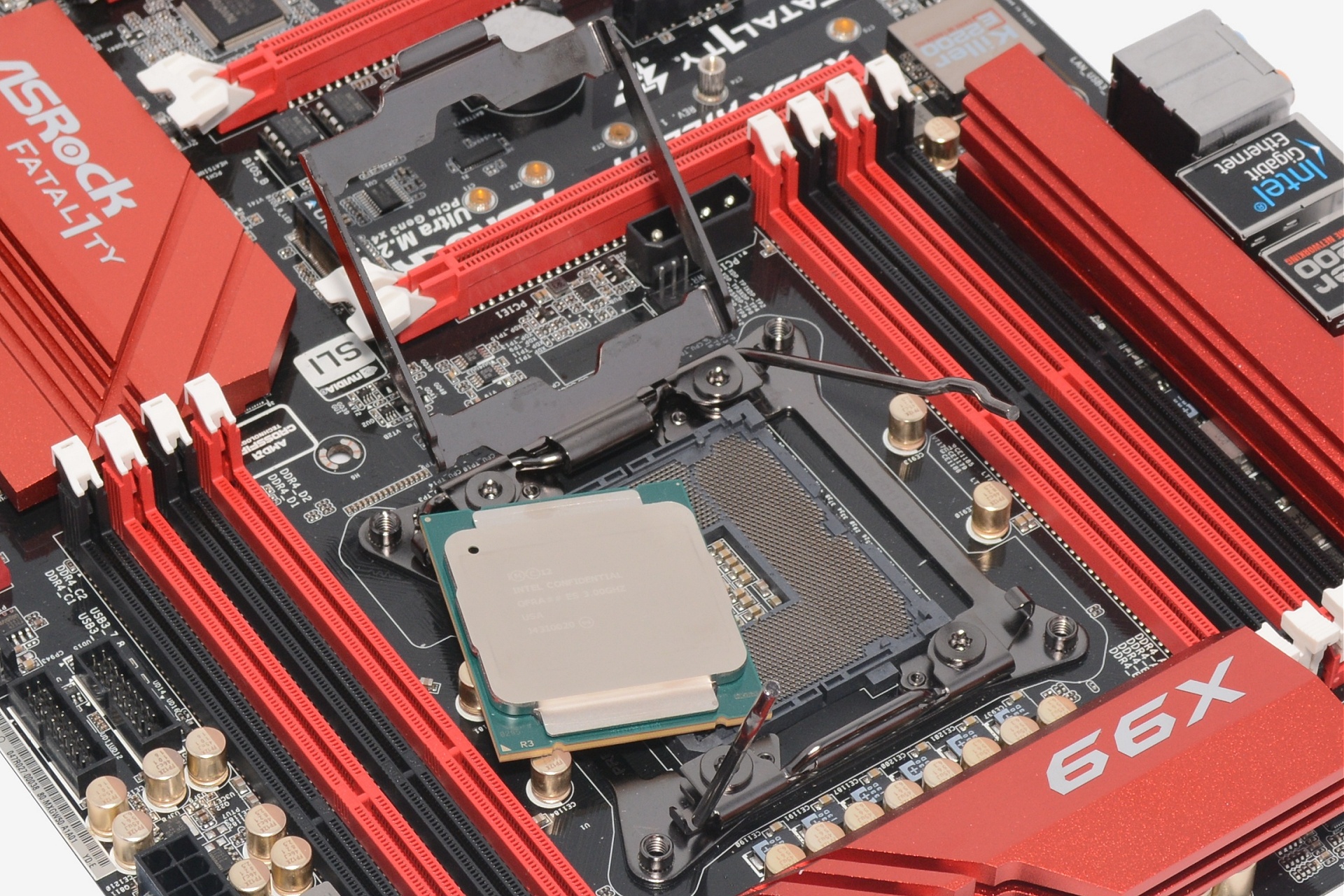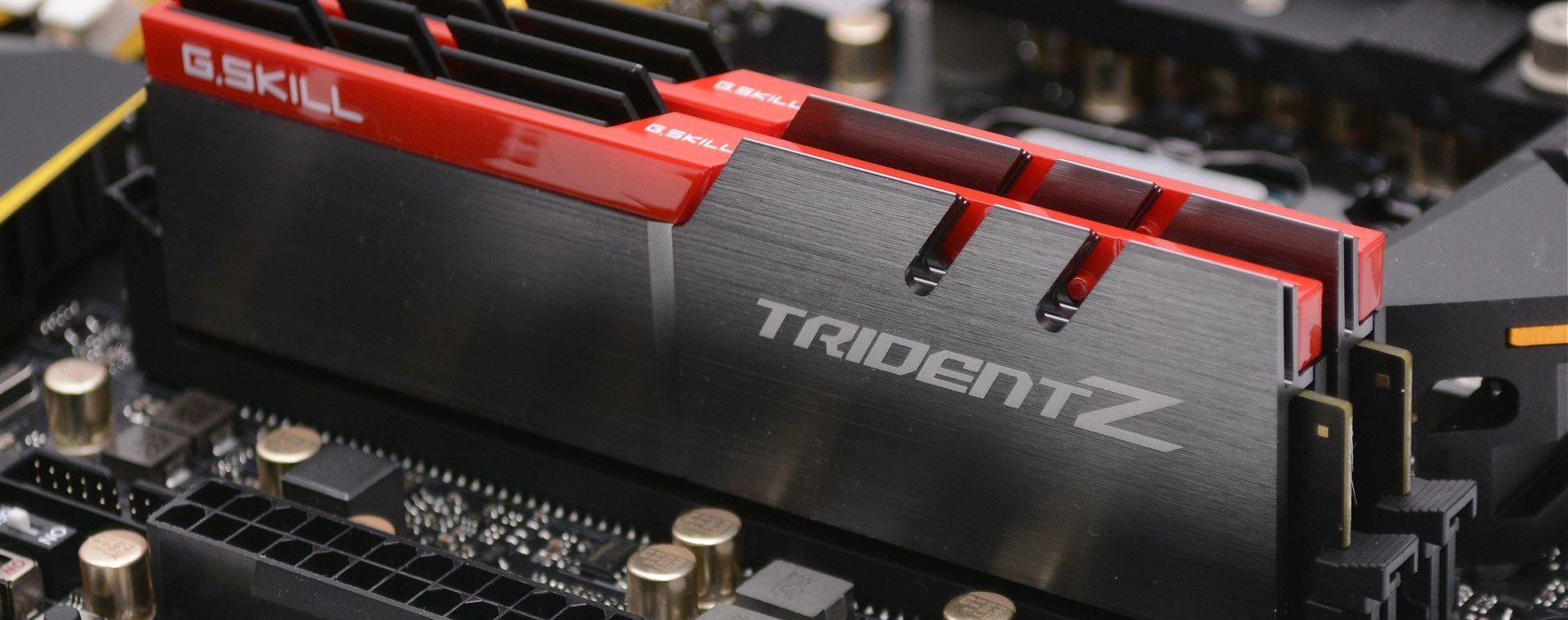004 Archivespast twelve months turned out to be some of the most exciting times we can remember for building a new computer. Last March saw the launch of Ryzen ending half a decade of AMD being 'bulldozed' by the competition. From that point forward it was busy for PC hardware, including the release of new graphics cards and Intel having a second go at things with Coffee Lake after an underwhelming Kaby Lake launch. However, for as much as there was to be excited about regarding computer hardware in 2017, there was plenty to be upset about as well.
Unfortunately, some of these problems have gotten worse and will probably continue to worsen throughout 2018, which is going to make it increasingly difficult to build a PC. Part one of this series will be dedicated discuss DDR4 memory pricing and why it's so high.
RAM pricing is currently a big issue plaguing those wanting to build a new computer or even update an old one. From July 2016 to July 2017, the market saw a 111% increase for the average selling price of DDR4 memory, and it has continued to increase since then.

An 8GB DDR4-2400 memory kit went for around $35 in 2016. A year later you could expect to pay a little over $70 for the same product. Today you're looking at an asking price of at least $90, or 170% more than what we were paying roughly 18 months ago.
But why is this? First and foremost, it's an issue of supply and demand. And while it's difficult to predict exactly when supply will improve, most reports suggest this won't happen until late 2018 when manufacturing of 64-layer and 96-layer 3D NAND flash reaches maturity. Until then, demand will continue to heavily outweight supply.
So, okay, it's a supply issue – but why? What's the main driver behind either supply decreasing or demand increasing? I believe we've been faced with a sort of double whammy.
The major DRAM suppliers shifted focus away from DDR4 production due to tight margins, investing elsewhere, while growth in the traditional desktop sector over previous years was slow and nobody wanted to pay a premium for DDR4 products, resulting in a loss of interest from manufacturers who couldn't meet their planned targets and returns.

With limited demand in late 2014 with Intel's Haswell-E and Haswell-EP range which continued in 2015 with Skylake and then again 2016 with Broadwell-E, the limited supply wasn't an issue. However, in 2017 we saw a rapid shift in market demand toward desktop computing, not just Intel but now also AMD were shipping processors supporting DDR4 memory.
Perhaps an even bigger factor, the smartphone industry has increased demand of not just DRAM but NAND as well. It's worth highlighting that it's a different type of DDR4 memory which is produced for the mobile market (Low Powered DDR4 or LP DDR4), and manufacturers such as Samsung make more profit selling LPDDR4 memory in premium smartphones.
With demand outweighing supply, prices increased and DDR4 margins were no longer tight. By mid-2017, pricing of memory modules soared significantly and unfortunately it doesn't look like manufacturers will be ramping up production any time soon.
According to market research firm DRAMeXchange, the three major DDR4 suppliers (Samsung, SK Hynix and Micron) slowed down their capacity expansions and technology migrations to maintain prices in 2018 at the same levels seen in the second half of last year, which is presumably related to their interest in sustaining strong profit margins.
The construction of new fabs is underway to help the strained supply but they won't be ready for mass production until 2019 at the earliest. It's predicted by Gartner that DDR4 pricing will crash in 2019 and history would suggest this is likely to happen as that's the cycle we go through every few years with memory pricing.
China has the potential to change things here with its aggressive approach to the semiconductor market, which could cause pricing to become even more unpredictable. Chinese memory could flood markets worldwide causing pricing to plummet. Right now there is a large number of Chinese fabs being built and it is expected that the country will take second place for investment in semiconductors this year as it equips the many new fabs that began construction in 2016 and 2017.

It's also been reported that China's National Development and Reform Commission is investigating the possibility of DRAM price-fixing between the major industry players, and this has of course been sparked by the price surge we've been talking about. If found guilty, it's hard to predict what the ramifications would or could be, so we'll have to see how that story plays out. It would appear as though they do have quite a bit of power here, as SK Hynix and Samsung both have a number of facilities in China.
So if you have a choice: hold off on building your new PC until later in 2018 (or longer) or simply accept the hit on memory pricing. PC gamers will ideally want 16GB these days and those kits cost at least $170, with premium memory priced closer to $200. Granted, the same kit would have costed around $75 in the good old days, but try not to dwell on that.
Inflated DDR4 memory pricing is only one of the problems you can expect to face when looking to upgrade or build a PC in 2018, and in the next part of this series we're going to discuss what's going on with GPU pricing and what we can expect later this year.
2017 was an exciting year for PC hardware but it wasn't all roses. The warning signs we saw are painting more difficult in 2018. In this 3-part series we discuss why building a new gaming PC is not a great idea at the moment, or at the very least, it's going to come at great expense.
 Robin Triumphant
Robin Triumphant
 Google's Titan Security Key bundles FIDO with extra verification
Google's Titan Security Key bundles FIDO with extra verification
 Fears of Clippy the paperclip resurface after Microsoft buys LinkedIn
Fears of Clippy the paperclip resurface after Microsoft buys LinkedIn
 10 years later, a look back at 'Step Brothers'
10 years later, a look back at 'Step Brothers'
 Robin Triumphant
Robin Triumphant
 Samsung's teaser for the Galaxy Note 9 is a horror movie for geeks
Samsung's teaser for the Galaxy Note 9 is a horror movie for geeks
 Augur protocol leads to Ethereum
Augur protocol leads to Ethereum
 Dude uses Facebook to prank the internet into thinking he can see the future
Dude uses Facebook to prank the internet into thinking he can see the future
 Wombat butt biting sex habits could be helpful for its survival
Wombat butt biting sex habits could be helpful for its survival
 Alexa Cast lets you stream Amazon Music to an Echo
Alexa Cast lets you stream Amazon Music to an Echo
 Best smartwatch deal: Save $40 on the Fitbit Versa 4
Best smartwatch deal: Save $40 on the Fitbit Versa 4
 Apple's 2018 MacBook Pro can't recover data if the logic board fails
Apple's 2018 MacBook Pro can't recover data if the logic board fails
 These are the companies with the fewest women in leadership roles
These are the companies with the fewest women in leadership roles
 Microsoft has a plan for keeping the cost of a next
Microsoft has a plan for keeping the cost of a next
 Wingsuit flyer glides down 8,000 feet to grab a donut in new commercial
Wingsuit flyer glides down 8,000 feet to grab a donut in new commercial
 Donald Trump has jumped on the 'shadow ban' Twitter conspiracy theory
Donald Trump has jumped on the 'shadow ban' Twitter conspiracy theory
 Apple's 2018 MacBook Pro can't recover data if the logic board fails
Apple's 2018 MacBook Pro can't recover data if the logic board fails
 Gods of War
Gods of War
 Arya Stark T
Arya Stark T
People with disabilities now have their own relevant version of YelpLooks like Hillary Clinton and the internet are on the same page about this Mike Pence email thingObsessed with the TrumpThis chatbot helps refugees claim asylum, for freeFacebook sees Uber as a threat, says exec'Harry Potter and the Cursed Child' gets the most Olivier Award nominations in historyKellyanne Conway makes mistakes, just like the Oscars, says Kellyanne ConwayResearchers use brain waves to correct robot mistakesThe office furniture of the future actually looks pretty goodStarbucks is selling cold brew in jars because it wants in on the hipster market tooJay Z's venture capital fund is hereThis week in apps: McDonald's, Duolingo's flashcards, and Meet by GoogleTom Hanks and Meryl Streep to lead Steven Spielberg's Pentagon Papers dramaEveryone needs to hear Justin Timberlake's inclusive iHeartRadio Music Awards speechListen to Willow Smith sing the song Carrie Fisher wrote with Sean LennonThe latest leak of the Samsung Galaxy S8 reveals a lot about its home buttonNintendo to Switch owners: Avoid aquariums if you're having JoyWatch this bro get into the Trolling HallMike Pence wants an apology after the AP publishes second lady's email addressForever alone: Why too much social media use might lead to loneliness Dating advice for singles: Don't get hung up on Dating Sunday TikTok is Twee now The Paris Review of the Air—and Land, and Sea Charles Coypel’s Lavish, Theatrical “Don Quixote” Tapestries Goya’s Funny, Disquieting Drawings of Witches and Crones When Did Table Settings Become So Lavish? Staff Picks: Mantel, Kleeman, Burchfield “Say Stupid Shit”: A French Philosopher Mutters to Himself A cat on TikTok is piggy dippin' in the piggy pond Be a Doll—Save a Life New Stories Found from Twain’s Days as a Newspaperman When You’re Arguing About Ogden Nash, No One Wins Withings' Body Scan scale wants to measure your foot sweat Staff Picks: Barba, Norris, T.H. White The Art of the Signature Is in Decline How to watch the Arkansas vs. LSU football matchup without cable TikTokker shares her creepy ‘driverless Uber’ experience. Here’s how it works step Nicholson Baker’s Favorite Vacuum Cleaner Twitter/X is killing Circles How chronic urinary tract infections (UTIs) affect your sex life
1.8551s , 10133.3671875 kb
Copyright © 2025 Powered by 【2004 Archives】,Steady Information Network